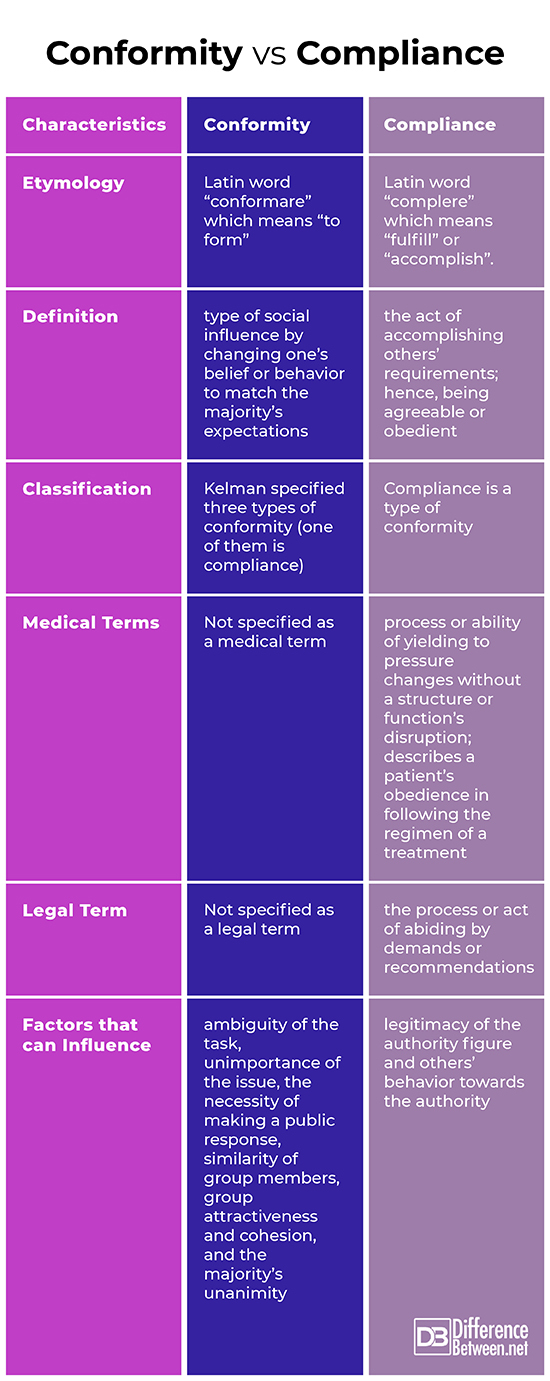Difference Between Conformity and Compliance
Both conformity and compliance involve behavioral change and are concepts associated with social psychology. They are often interchangeably used since “compliance with” is a synonym of “conform”. However, compliance is a momentary change of behavior and is defined as a type of conformity. The following discussions further delve into their distinctions.

What is Conformity?
“Conformity” came from the Latin word “conformare” which means “to form”. It is a type of social influence by changing one’s belief or behavior to match the majority’s expectations. This was first studied by Arthur Jenness(1932) who asked individuals to estimate how many beans does a bottle contain (Sparks, 2018). The participants were then led into a room where they were able to discuss about the number of beans. After the group’s estimate, Jenness individually asked the participants if they would like to change their first answer. The results showed that almost all of the respondents changed their initial estimates to be closer to the group’s answer. This then implies that decisions are substantially influenced by others’ opinions, specifically in ambiguous circumstances.
Kelman (1958) identified the following three types of conformity:
- Compliance
Compliance is a momentary behavior change since it stops without the majority’s expectations. This occurs when an influence is accepted even if there is no personal or sincere agreement. The change of behavior is merely motivated by the desire to receive group approval or a similar positive response. For instance, a politician is very polite and cordial when speaking in front of the camera; however, he speaks harshly and rudely when no one is filming or recording.
- Identification
Identification happens when people change their behaviors to be able to be a part of certain groups. As compared to compliance, this type is stronger since it involves both private and public conformity. Nonetheless, it may cease when the membership is terminated. For instance, a college student joined a club and adhered to their organization’s norms. However, he had to transfer to another university; he then joined a different club with a different set of norms.
- Internalization
Similar with identification, internalization is characterized by both private and public conformity. However, internalization is deeper and stronger since the change lasts longer and is usually permanent. In this type, there is a meaningful and very personal conviction. One of the most common examples is a change of behavior due to spiritual or religious beliefs.

What is Compliance?
Compliance came from the Latin word, “complere” which means “fulfill” or “accomplish”. It is the act of accomplishing others’ requirements; hence, being agreeable or obedient. As mentioned above, it is one of the three types of conformity according to Kelman. It is the weakest type since it is a temporary change which only happens with the presence of an apparent social pressure.
In medicine, compliance refers to the process or ability of yielding to pressure changes without a structure or function’s disruption. For instance, pulmonary compliance refers to the lung’s capability to enlarge and stretch. This term also describes a patient’s obedience in following the regimen of a treatment. For example, “patient compliance” is correlated with a faster recovery rate. From the legal perspective, compliance is the process or act of abiding by demands or recommendations. For instance, a business establishment is complying with social distancing protocols and the official requirements during the pandemic.
Difference between Conformity and Compliance
Etymology
“Conformity” came from the Latin word “conformare” which means “to form” while compliance came from the Latin word “complere” which means “fulfill” or “accomplish”.
Definition
Conformity is a type of social influence by changing one’s belief or behavior to match the majority’s expectations. In comparison, compliance is the act of accomplishing others’ requirements; hence, being agreeable or obedient.
Classification
Kelman identified compliance as one of the three types of conformity. Compliance is a momentary behavior change which stops when the majority’s expectations also stops. This occurs when an influence is accepted even if there is no personal or sincere agreement.
Medical Terms
Compliance is a technical term in the medical field. According to Merriam-Webster Dictionary, it refers to the process or ability of yielding to pressure changes without a structure or function’s disruption (i.e. pulmonary compliance). Moreover, it describes a patient’s obedience in following the regimen of a treatment (i.e. patient compliance). On the other hand, conformity is not a jargon associated with the medical and legal fields.
Legal Term
From the legal perspective, compliance is the process or act of abiding by demands or recommendations. For instance, a business establishment is complying with social distancing protocols and the official requirements during the pandemic. In comparison, Merriam-Webster Dictionary does not specify conformity as a specific legal term.
Factors that can Influence
Conformity can be increased by the ambiguity of the task, unimportance of the issue, the necessity of making a public response, similarity of group members, group attractiveness and cohesion, and the majority’s unanimity. In comparison, compliance can be increased by the legitimacy of the authority figure and others’ behavior towards the authority (Ridgeway, 2020).
Conformity vs Compliance

Summary
- Conformity is a type of social influence by changing one’s belief or behavior to match the majority’s expectations.
- Compliance is the act of accomplishing others’ requirements; hence, being agreeable or obedient.
- Kelman identified compliance as one of the three types of conformity.
- Compliance is a term in the medical and legal fields.
- Difference Between Hematoma and Melanoma - February 9, 2023
- Difference Between Bruising and Necrosis - February 8, 2023
- Difference Between Brain Hematoma and Brain Hemorrhage - February 8, 2023
Search DifferenceBetween.net :
1 Comment
Leave a Response
References :
[0]Kelman, Herbert. Compliance, Identification, and Internalization: Three Processes of Attitude Change. Journal of Conflict Resolution. 1958;2 (1) :51-60.
[1]Ridgeway, Cecilia. Compliance and Conformity. Encylopedia.com, 2020. https://www.encyclopedia.com/social-sciences/encyclopedias-almanacs-transcripts-and-maps/compliance-and-conformity
[2]Sparks, Joseph. Types of Conformity. Tutor2u, 2018. tutor2u.net/psychology/reference/types-of-conformity
[3]Image credit: https://pixabay.com/da/illustrations/politikker-standarder-overholdelse-4720824/
[4]Image credit: https://commons.wikimedia.org/wiki/File:Explanation_of_pre_and_post_warnings_agaisnt_memory_conformity.png

Thank you